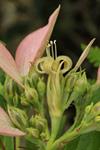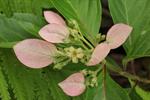Click the number at the start of a key lead to highlight both that lead and its corresponding lead. Click again to show only the two highlighted leads. Click a third time to return to the full key with the selected leads still highlighted.
1 Trees, shrubs, or woody vines. |
..2 Prostrate or climbing woody vines (lianas), or sprawling shrubs. |
....3 Leaf bases cordate, rounded, or truncate; leaves usually cordate, ovate, or deltoid shaped (occasionally hastate or broadly elliptic); corolla pale lilac colored; [non-native, se. US including FL; tribe Paederieae] |
....3 Leaf bases cuneate to rounded but not cordate; leaves oblanceolate, lanceolate or linear; corolla white or yellow; [native, FL]. |
......4 Flowers and fruit sessile or subsessile; fruit yellow |
......4 Flowers and fruit borne on pedicels or peduncles; fruit white |
..2 Shrub or tree, plants upright. |
........5 Inflorescence spherical or globular, in a tight round head; [collectively widespread] |
..........6 Fruits dry, dehiscent; [subfamily Cinchonoideae; tribe Naucleeae] |
..........6 Fruits fleshy, indehiscent; [subfamily Rubioideae; tribe Morindeae] |
........5 Inflorescence cymose, thyrsoid, or corymbose (the inflorescence more open, not round and compact); [Coastal Plain, from s. SC southward]. |
............ 7 Plants with paired spines. |
............ ..8 Corolla lobes 4; leaves to ca. 1 cm long; fruit ca. 5 mm long |
............ ..8 Corolla lobes 5; leaves ca. 2-5 cm long ; fruit ca. 10 mm long |
............ 7 Plants unarmed, not bearing spines or thorns. |
............ ....9 Flowers orange-red; leaves usually whorled; [subfamily Cinchonoideae; tribe Hamelieae] |
............ ....9 Flowers white, green, or maroon; leaves opposite. |
............ ......10 Leaves linear, revolute, and strongly congested; [FL keys southward] |
............ ......10 Leaves broad, not linear, nor strongly congested; [collectively more widespread] |
............ ........11 Flowers solitary, terminal; [subfamily Ixoroideae; tribe Gardenieae] |
............ ........11 Flowers in cymose or thyrsoid inflorescences. |
............ ..........12 Inflorescence cymose; some calyx lobes expanded into pink or reddish “flags”; leaves deciduous; domatia not present; [of s. SC southward]; [subfamily Ixoroideae; tribe Condamineeae] |
............ ..........12 Inflorescences thyrsoid; calyx lobes inconspicuous; leaves evergreen; domatia present in secondary vein axils; [of ne. FL southward] |
 Show caption*© Sequoia Janirella Wrens, some rights reserved (CC BY-NC), uploaded by Sequoia Janirella Wrens Show caption*© Sequoia Janirella Wrens, some rights reserved (CC BY-NC), uploaded by Sequoia Janirella Wrens ............ ............ 13 Lateral veins 3-6 on either side of the midvein; fruit white; petals yellowish, > 6 mm long; [subfamily Cinchonoideae; tribe Chiococceae] |
............ ............ 13 Lateral veins 8-14 on either side of the midvein; fruit red; petals white, <5 mm long; [subfamily Rubioideae; tribe Psychotrieae] |
1 Herbs (or creeping subshrubs in Mitchella). |
............ ............ ..14 Leaves whorled; [subfamily Rubioideae; tribe Rubieae] |
............ ............ ..14 Leaves opposite |
............ ............ ....15 Flowers paired, the ovaries connate and developing into a single fleshy red fruit; leaves roundish; creeping subshrub; [subfamily Rubioideae; tribe Mitchelleae] |
............ ............ ....15 Flowers single or in inflorescences with multiple flowers, the fruits either dry or fleshy and yellowish or black; leaves various; herb; [subfamily Rubioideae; tribe Spermacoceae]. |
............ ............ ......16 Carpels with few to many seeds. |
............ ............ ........17 Corolla 5-lobed |
............ ............ ........17 Corolla 4-lobed. |
............ ............ ..........18 Capsule longer than the calyx tube; flowers blue, pink, or white |
............ ............ ..........18 Capsule not longer than the calyx tube; flowers white |
............ ............ ......16 Carpels 1-seeded. |
............ ............ ............ 19 Flowers in dense, terminal, involucrate heads; flowers 4- or-6-lobed; styles 3 |
............ ............ ............ 19 Flowers in axillary or terminal clusters, or single in axils, not involucrate; flowers 4-lobed; styles 2. |
............ ............ ............ ..20 Flowers usually solitary in leaf axils; fruit separating into 2 parts. |
............ ............ ............ ....21 Sepals 4 and similar in size; style entire; [of dry habitats] |
............ ............ ............ ....21 Sepals 2 (or 4, and then markedly dimorphic); style cleft; [of moist to wet habitats] |
............ ............ ............ ..20 Flowers in terminal and axillary clusters; fruits not separating into 2 parts. |
............ ............ ............ ......22 Carpels opening transversely |
............ ............ ............ ......22 Carpels opening longitudinally |
1 Aerial and epiphytic, hemiparasitic shrub |
1 Terrestrial, autotrophic or hemiparasitic shrub or subshrub. |
..2 Leaves succulent, nearly as thick as wide; [brackish to saline situations] |
..2 Leaves herbaceous (succulent in Borrichia), much wider than thick; [various habitats]. |
....3 Creeping or short subshrubs, the stems primarily prostrate, < 2 dm tall. |
......4 Well-developed leaves 4-6 per stem; inflorescence a head subtended by 4 large white bracts |
......4 Well-developed leaves many per stem; inflorescence of individual flowers axillary in pairs or clusters or in terminal cymes. |
........5 Flowers yellow; leaves with pellucid or dark punctate glands (use at least 10× magnification) |
........5 Flowers white, pale pink, or deep pink; leaves lacking sessile, punctate glands. |
..........6 Leaves linear; flowers pale to deep pink, 5-merous |
..........6 Leaves orbicular or elliptic; flowers white to pale pink, 4-merous or 5-merous |
............ 7 Leaves elliptic; flowers 5-merous; fruit a brownish capsule |
............ 7 Leaves orbicular; flowers 4-merous; fruit a red berry |
....3 Upright or scrambling shrubs, > 3 dm tall |
............ ..8 Scrambling shrubs, armed with recurved paired spines at the nodes |
............ ..8 Upright shrubs, unarmed. |
............ ....9 Inflorescence a terminal head of many flowers. |
............ ......10 Head spherical, lacking an involucre of conspicuous bracts or phyllaries |
............ ......10 Head flattened, either subtended by 4 large white bracts or by an involucre with >5 green phyllaries. |
............ ........11 Head subtended by 4 large white bracts; leaves with prominently parallel-arcing secondary veins; flowers 4-merous |
............ ........11 Head subtended by an involucre of >5 green phyllaries; leaves with venation otherwise; flowers 5-merous |
............ ....9 Inflorescence otherwise, either of a solitary flower, or one of a wide variety of inflorescences with flowers attached at different points along branched or unbranched axes (e.g. axillary). {add: [ Lagerstroemia] LYTHRACEAE; [ Rosmarinus] LAMIACEAE; [ Laguncularia] COMBRETACEAE; [ Buxus] BUXACEAE; [ Exochorda] ROSACEAE; various other [see spreadsheet]} |
............ ..........12 Inflorescence flat-topped (broader than long), terminal, a compound cyme or corymb. |
............ ............ 13 Flowers bright yellow; stamens many; leaves < 1.5 cm wide; fruit a capsule; leaves with pellucid or dark punctate glands (use at least 10× magnification) |
............ ............ 13 Flowers white or creamy; stamens 4-5; leaves > 1.5 cm wide; fruit a drupe; leaves lacking sessile, punctate glands. |
............ ............ ..14 Petals 5; foliage with simple hairs |
............ ............ ..14 Petals 4; foliage with T-shaped hairs |
............ ..........12 Inflorescence either terminal and not flat-topped (longer than wide), or axillary and variously shaped, or terminal and solitary, or leaf-opposed. |
............ ............ ....15 Carpels many (> 9), either separate or fused; stamens many; perianth segments either many and undifferentiated into calyx and corolla, maroon, brown, or yellow (in CALYCANTHACEAE), or differentiated into a fleshy and persistent calyx of 5-9 sepals, and a deciduous corolla of 5-9 red (or white) petals ( Punica in LYTHRACEAE). |
............ ............ ......16 Fruit a wrinkled, 3-7 cm long, brown to black, elliptical aggregate of nearly spherical, large achenes; flowers solitary in axils; perianth segments many and undifferentiated into calyx and corolla, maroon, brown, or yellowish; ovary superior; branches unarmed |
............ ............ ......16 Fruit a leathery, 4-15 cm in diameter, reddish, spherical berry with obpyramidal seeds surrounded by a juicy sarcotesta (pomegranate); perianth differentiated, the sepals fleshy and persistent on the fruit, the petals deciduous, 5-9, bright red to white; ovary inferior; branches typically armed with axillary spines |
............ ............ ....15 Carpels 1-5, fused; stamens either 1-5 or 8-10; perianth segments 4-5 or 8, variously colored; fruit a simple capsule, drupe, or berry (including berry-like fruit); flowers 2-many, in axillary or terminal inflorescences (pistillate flowers sometimes solitary in SANTALACEAE and THESIACEAE); [Eudicots]. |
............ ............ ........17 Ovary inferior; corolla absent, radially symmetrical, or bilaterally symmetrical; fruit either a berry or a 1-seeded drupe. |
............ ............ ..........18 Flowers unisexual and plants dioecious; corolla absent; pistillate flowers solitary, staminate flowers in pedunculate umbels or cymes, either terminal or axillary; fruit a 1-seeded drupe; leaves acute to acuminate at the apex |
............ ............ ............ 19 Inflorescences terminal |
............ ............ ............ 19 Inflorescences axillary |
............ ............ ..........18 Flowers bisexual and plants hermaphroditic; corolla present; flowers paired, terminal or axillary, or in axillary spikes; fruit a berry; leaves rounded, obtuse, to acute (or acuminate in Lonicera maackii) at the apex |
............ ............ ........17 Ovary superior; corolla radially symmetrical (absent in Forestiera in OLEACEAE); fruit either a 1-4-seeded drupe, or a many-seeded berry (or berry-like fruit), or a capsule. |
............ ............ ............ ..20 Leaves with a conspicuous mix of silvery stellate hairs (upper) and rusty colored scales (lower); ovaries bearing rusty colored scales; flowers small, yellowish and inconspicuous; [nw. PA northward] |
............ ............ ............ ..20 Leaves glabrous or nearly so, lacking a conspicuous mix of stellate hairs adaxially and rusty scales abaxially; ovaries not bearing rusty colored scales; flowers of various size and color. |
............ ............ ............ ....21 Stamens 8-10, of 2 different lengths in each flower; petals separate, 4-5 (-7), pink purple, 10-15 mm long; stems strongly arching, rooting at the tips; [plants of flooded to saturated wetlands] |
............ ............ ............ ....21 Stamens either (1-) 2 (-4), or 4-5, or 10, all of the same length; petals fused (separate in RHAMNACEAE and BUXACEAE, but then < 5 mm long and white or cream), white, bright-yellow, lilac, or pink; stems erect (or at least not arching and rooting at the tips); [plants of various habitats]. |
............ ............ ............ ......22 Petals separate, 4-5, white or cream; stamens 4-5. |
............ ............ ............ ........23 Fruit a loculicidal capsule, dehiscing into 3 valves; branches square in ×-section; leaves < 2 cm long; [exotic, cultivated and weakly established, of temperate areas] |
............ ............ ............ ........23 Fruit a drupe with 2-4 pyrenes; branches round or nearly so in ×-section; leaves > 2 cm long; [natives, of peninsular FL] |
............ ............ ............ ......22 Petals fused, 4-5, white, bright yellow, lilac, or pink; stamens either (1-) 2 (-4) or 10; fruit either a capsule or a 1-seeded drupe. |
............ ............ ............ ..........24 Perianth 5-merous; corolla pink; stamens 10; fruit a 5-locular capsule |
............ ............ ............ ..........24 Perianth 4-merous; corolla white, bright yellow, or lilac; stamens (1-) 2 (-4); fruit either a 1-seeded drupe or a 2-locular capsule |






